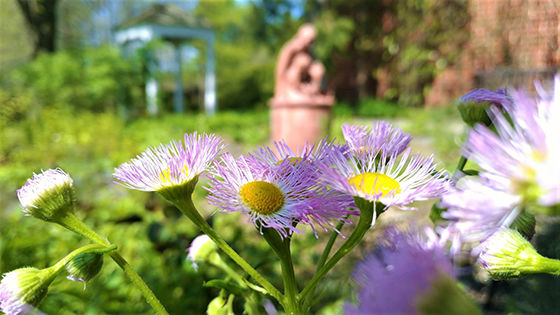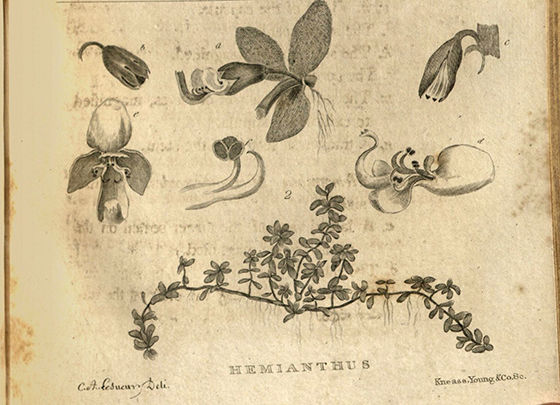When you think of plants, the first adjective that comes to mind probably isn't “scary.” But how about a plant that eats meat? Or a giant flower that smells like a dead body? How about a parasitic flower that has no body of its own? Or plant growths that look like something otherworldly is sure to hatch out of them at any moment? Did we mention a fungus that turns ants into zombies? The world of plants and fungi is freaky, fascinating and seriously weird.
Two Rare Corpse Flowers Bloom at the Temple Ambler Campus Greenhouse
In May 2021, not one but two giant corpse flowers bloomed in the Tyler School of Art and Architecture's Greenhouse Education and Research Complex at Temple Ambler! The giant corpse flower (Amorphophallus titanum) produces the world's largest unbranched inflorescence, or flower structure. A flowering corpse flower, which is endangered in its natural habitat of Sumatra, is a truly rare event considering that it takes seven to 10 years for the plant to bloom. To have two was extraordinary. The big bloom, now named "Big Stinker," had a "Mini-me" in the form of "Lil Stinker!"
Corpse Flowers do an excellent job of living up to the name. When they bloom, they will smell like rotting meat. Unlike other flowers that use their scent to attract bees and butterflies as pollinators, the corpse flower sends out its eye-watering odor to attract flies and beetles. Visit Temple Ambler's visit Corpse Flower Central - https://ambler.temple.edu/corpseflower - for all of the news about these marvelously strange blooms!
Weird Plants in the Greenhouse: Carrion Flower (Stapelia leendertziae)
You joined us on our wonderfully strange journey with not one but to corpse flowers! Now it’s time to learn about some of the other strange and fascinating residents of the Tyler Greenhouse Education and Research Complex at Temple Ambler. Join Greenhouse Complex Manager Benjamin Snyder for our Weird Plant of the Month!
We’re exploring Stapelia leendertziae, more commonly known as Carrion Flower, Black Bells and Star Flower. This fragrant beauty produces 31 scent compounds, most of which contain sulphur, and two of which are very close to those produced by a decaying rat (yes, you read that correctly).
Weird Plants in the Greenhouse: Ant Plant and Air Plant
We are back for another trip into the Tyler School of Art and Architecture Greenhouse Education and Research Complex at Temple Ambler for a look at some of our weird plants!
Join Greenhouse Complex Manager Benjamin Snyder for our Weird Plant of the Month! For August, we’re exploring not one, but two plants — Hydnophytum formicarum, or Ant Plants, and Tillandsia bulbosa, or Bulbous Air Plant.
The Ant Plant is an epiphytic example of a myrmecophyte, or a plant that has a symbiotic relationship with ants, thus the common name of "ant plant." This particular ant plant is in the Rubiaceae, or madder, family — the same family as the coffee plant — and is native to rainforests in Southeast Asia.
Like the Ant Plant, the Bulbous Air Plant is another epiphytic myrmecophyte. This one is native to southern Mexico, the West Indies and South America. It is much smaller in size and features thin, twisting leaves originating from an oval-shaped base. Being smaller, the bulbous air plant typically house smaller populations of ants, but the symbiosis is the same.
A Walk on the Weird Side of the Ambler Campus Greenhouse
The plants in the Greenhouse Education and Research Complex, a key component in the Temple Tyler School of Art and Architecture’s Landscape Architecture and Horticulture programs, are being diligently cared for at Temple Ambler. Some are plants you're likely familiar with - lush, green and flowering. Others take a decidedly strange and fascinating turn for the weird. The Greenhouse provides a perfect home for an eclectic group of carnivorous plants, spiny cacti of every shape and size, and species that are a great deal more bizarre. Read More.
Learn About Poison Ivy and Virginia Creeper
If Poison Ivy sends you walking (or running) in the opposite direction, have no fear! Kathy Salisbury, Director of the Ambler Arboretum of Temple University, invites you to learn about this important native plant. She’ll also share how to tell Poison Ivy apart from the lookalike Virginia Creeper.
A Whole Lot of Galls
What are those things on the leaves? As you take your nature walks around the neighborhood or venture into local parks, you may notice weird growths on the leaves of plants. They may look kind of alien or gross to you but they are really fascinating. These growths are called galls. Galls are abnormal cell growth. While we mostly see them on leaves or stems when we are exploring, they can also form on roots and even flowers. These lumps and bumps are caused by irritation to the plant's surfaces. Read More. Seeking a little more gall knowledge? Kathy Salisbury, Director of the Ambler Arboretum of Temple University, spotlights petiole galls on black walnut trees.
Skunk Cabbage — It Lives Up to Its Name
If you happen to take a walk into damp shaded woods, perhaps next to a creek or stream or along a boardwalk, you may encounter Skunk Cabbages (Symplocarpus foetidus). Skunk Cabbage are thermogenic. This means it makes its own heat, like we do (sort of)! The flower temperature may exceed the air temperature by up to 77 degrees! And yes, they are smelly, which is why it is called skunk cabbage! The odor is emitted when the flowers warm up or when the leaves are crushed. Flies and other insects find the scent alluring and venture inside the warm flower and end up pollinating the plant while warming up. Read More.
What’s In A Name?

Perhaps as you have been exploring the natural areas around you and learning the names of plants you have encountered some strange names. All plants have a scientific name. This is the name written in italics and it is the same all over the world. There is only one plant with this scientific name. Plants also have common names. These are names given to the plants regionally by the people who use the plant or grow the plant. While the scientific names of plants can be interesting in their own way, common names are often interesting too — and sometimes just plain weird as Kathy Salisbury, Director of the Ambler Arboretum of Temple University, explains. Read More.
Fungi in the Forest
Fungi — including various mushrooms, molds, and yeasts — are critical players in the forest ecosystem. This video explores the various roles of fungi as parasites, decomposers, and cooperative partners with trees, and features the research of Harvard scientist Anne Pringle. The video is presented by the Harvard Museum of Natural History.
Zombie Ants! Run!
Yes, there are “real” zombies? In this case, however (and fortunately), the zombies aren’t coming to eat your brain. They are ants that have been taken over by a fungus, cordyceps (Ophiocordyceps unilateralis), in order to reproduce. Video produced by National Geographic. Read more about zombie ants here.
Attack of the Killer Fungi (or Return of the Zombie Ants)
The cordyceps are back and have targeted bullet ants, taking over their bodies and their minds! This video by BBC Studios explores the stages of the parasitic attack. Want to know more? This article from The Atlantic explores the infamous parasite's methods.
Flies Better Look Out Too!
Something is growing inside that fruit fly in your kitchen. At dusk, the fly points its wings straight up and dies in a gruesome pose so that a fungus, the appropriately named “fly destroyer” (Entomophthora muscae) can ooze out and fire hundreds of reproductive spores! Video by Deep Look.
The Sole Native Pennsylvania Plant Is Now Extinct

It has been 203 years since Curator Thomas Nuttall read his description of a new species of small subaquatic plant he discovered to the other members of the Academy of Natural Sciences of Philadelphia. The new species was Hemianthus micranthemoides, and he discovered it along the Delaware River in Kensington, in Philadelphia. The species was later called Nuttall’s mudflower in his honor. Sadly, no one today is likely to witness the modest bloom of Nuttall’s mudflower, as it is the only plant species native to Pennsylvania that is now thought to be extinct. Read More.

